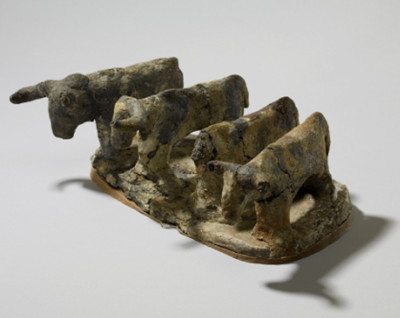'They were a very important part of the Egyptian economy. It became essentially a symbol for life.'
“它們是古埃及經濟相當重要的一部分,牛在本質上已經成為一種生命的象征。”
'It's not that easy for archaeologists to pin down how food processing worked in these early stages, but some of these artefacts can give us a good insight into it.'
“對于考古學家來說,精確地找出在這些人類早期階段食品加工究竟是怎么樣的,可不是一件輕松活;不過有些文物可以給我們提供一向很好的啟示。”
Our history of the world in 100 objects
100件藏品中的世界史
A painted clay medel of four cattle, approximately 5 and a half thousand years old.
四牛模型,彩繪泥塑,距今約五千五百年前。
Four horned cows stand side by side upon fertile land. And indeed they've been grazing on their little patch of grass for about five and a half thousand years. They're ancient Egyptian, more ancient even than the pharaohs or the pyramids.
這四只帶角的牛肩并肩站成在肥沃的土地上,它們就在那塊小草地上吃草,渡過了五千五百年的漫長歲月。它們來自古埃及,甚至比古法老金字塔的年代還要久
These cows are miniatures - small models, hand-moulded out of a single lump of Nile river clay. And on them you can still see very faint traces of black-and-white paint applied after the clay had been lightly baked.
這四只牛是實物小縮影,或者說是小模型,一次性手工造模成型,材料是一小塊尼羅河粘土。在它們身上,當初粘土微火烘培后所涂上的黑白涂料仍舊留有隱隱約約的痕跡。
Like toy farm-animals of the sort most of us played with as children, they stand only a few inches high, and the clay base that they share is roughly the size of a dinner plate. These cows were buried with a man in a cemetery near a small village near El Amra in southern Egypt.
就像我們當小孩時玩的玩具農場動物一樣,這些陶牛模型站著有幾英寸高,托著它們的粘土盤也就餐盤大小。這些陶牛是一個男性的隨葬品,地置大概在南部埃及靠近El Amra地區的小村落附近。












